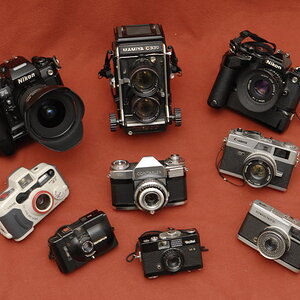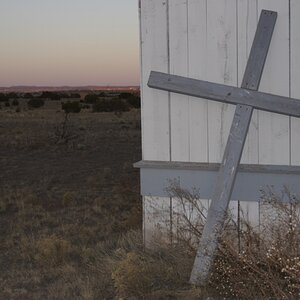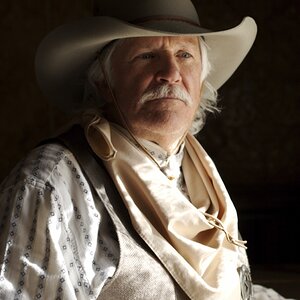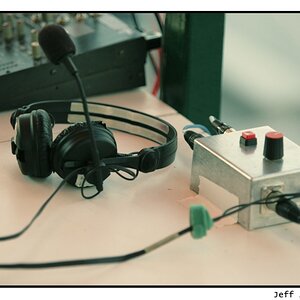Actor
TPF Noob!
- Joined
- Mar 4, 2007
- Messages
- 421
- Reaction score
- 1
- Location
- Ohio
- Can others edit my Photos
- Photos NOT OK to edit
It was one of those impromptu things, a photo op that just presented itself. I grabbed the only camera that was handy, my wife's DSLR. I quickly realized that it was set to B&W but, not being familiar enough with it to set it back to color quickly, I continued to shoot.
Turns out my daughter was taking a class in digital photography and she had an assignment to shoot in B&W. That's why the camera was in B&W mode. It seems to me that a B&W mode in a digital camera is unnecessary since every editing program I know of will do a color to B&W conversion.
Anyway I got to wonering if the same reasoning applies to film, i.e., shoot color negative and then, if you want, make a B&W print. I recall using a special paper back in the 70's that was specifically for making a B&W print from a color neg. Is that still available? Anyway, shooting a color neg would eliminate the "gee, I wish I'd shot that in color" problem.
Spielberg shot Schindler's List with color film and released the movie in B&W. I've heard two reasons for this, one being that Kodak could not supply enough B&W film, the other being that the studio wanted a safety net, a color print to release in case the B&W version tanked. I believe the second story.
For me the disadvantage of shooting color film for B&W prints is that I'd have to have a lab process it. Maybe C41 is different but back in the 70's color processing meant tighter temperature requirements, more steps, more chemistry and more chances to make mistakes.
But there's this to consider. It seems likely that a B&W negative will yield a better B&W print than a color negative. I recall reading somewhere that T-MAX 100 has a resolution of 200 lines/mm on the negative, more than twice what can be achieved with color. And I think some companies are still offering B&W film with ISO 50, maybe even ISO 25, that would have even better resolution.
I suspect you can achieve better contrast with a B&W neg. For that matter, if my understanding of the way variable contrast paper works is correct, the "special paper" for color negs cannot be variable contrast. Maybe I've talked myself out of this idea already.
Turns out my daughter was taking a class in digital photography and she had an assignment to shoot in B&W. That's why the camera was in B&W mode. It seems to me that a B&W mode in a digital camera is unnecessary since every editing program I know of will do a color to B&W conversion.
Anyway I got to wonering if the same reasoning applies to film, i.e., shoot color negative and then, if you want, make a B&W print. I recall using a special paper back in the 70's that was specifically for making a B&W print from a color neg. Is that still available? Anyway, shooting a color neg would eliminate the "gee, I wish I'd shot that in color" problem.
Spielberg shot Schindler's List with color film and released the movie in B&W. I've heard two reasons for this, one being that Kodak could not supply enough B&W film, the other being that the studio wanted a safety net, a color print to release in case the B&W version tanked. I believe the second story.
For me the disadvantage of shooting color film for B&W prints is that I'd have to have a lab process it. Maybe C41 is different but back in the 70's color processing meant tighter temperature requirements, more steps, more chemistry and more chances to make mistakes.
But there's this to consider. It seems likely that a B&W negative will yield a better B&W print than a color negative. I recall reading somewhere that T-MAX 100 has a resolution of 200 lines/mm on the negative, more than twice what can be achieved with color. And I think some companies are still offering B&W film with ISO 50, maybe even ISO 25, that would have even better resolution.
I suspect you can achieve better contrast with a B&W neg. For that matter, if my understanding of the way variable contrast paper works is correct, the "special paper" for color negs cannot be variable contrast. Maybe I've talked myself out of this idea already.



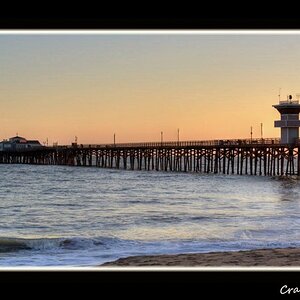
![[No title]](/data/xfmg/thumbnail/37/37492-bafc92488a1ab17e4ca6603ee5b38376.jpg?1619738112)
![[No title]](/data/xfmg/thumbnail/37/37603-739c5d9b541a083a12f2f30e45ca2b7b.jpg?1619738147)
![[No title]](/data/xfmg/thumbnail/42/42494-ba608b57b09b00c0ee005a2360a510f5.jpg?1619740198)


